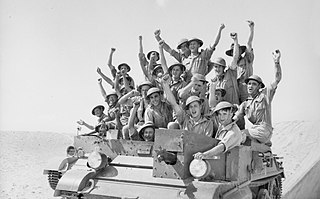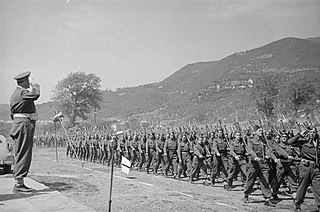
The First Australian Imperial Force was the main expeditionary force of the Australian Army during the First World War. It was formed as the Australian Imperial Force (AIF) following Britain's declaration of war on Germany on 15 August 1914, with an initial strength of one infantry division and one light horse brigade. The infantry division subsequently fought at Gallipoli between April and December 1915, with a newly raised second division, as well as three light horse brigades, reinforcing the committed units.

The Australian 4th Division was formed in the First World War during the expansion of the Australian Imperial Force (AIF) infantry brigades in February 1916. In addition to the experienced 4th Brigade were added the new 12th and 13th Brigades. From Egypt the division was sent to France, where it took part in the fighting on the Western Front during 1916–1918. After the war ended, the AIF was demobilised and the division was dissolved.

The German invasion of Greece, also known as the Battle of Greece or Operation Marita, were the attacks on Greece by Italy and Germany during World War II. The Italian invasion in October 1940, which is usually known as the Greco-Italian War, was followed by the German invasion in April 1941. German landings on the island of Crete came after Allied forces had been defeated in mainland Greece. These battles were part of the greater Balkans Campaign of the Axis powers and their associates.

The 2nd Division of the Australian Army, also known as the 2nd (Australian) Division, commands all the Reserve brigades in Australia. These are the 4th in Victoria and Tasmania, the 5th in New South Wales, the 11th in Queensland, the 13th in Western Australia, and the 8th spread across the country. The division is also responsible for the security of Australia's northern borders through its Regional Force Surveillance Units.

The 1st Division, also known as the 1st (Australian) Division, is a division headquartered in Enoggera Barracks in Brisbane. The division was first formed in 1914 for service during the First World War as a part of the Australian Imperial Force (AIF). It was initially part of the Australian and New Zealand Army Corps (ANZAC) and served with that formation during the Gallipoli campaign, before later serving on the Western Front. After the war, the division became a part-time unit based in New South Wales. During the Second World War it undertook defensive duties in Australia. It was disbanded in 1945.

The 16th Brigade was an infantry brigade in the Australian Army. First raised in 1912 as a Militia formation to provide training under the compulsory training scheme, the brigade was later re-raised as part of the First Australian Imperial Force during World War I. Its existence was short-lived, as it was disbanded after about six months, before it could be committed to the fighting on the Western Front. Raised again in 1939 for service during World War II, the brigade was deployed to the Middle East in early 1940 and subsequently saw action in the Western Desert and in Greece in 1941. In 1942, it returned to Australia in response to Japan's entry into the war, and later the brigade played a prominent role in the Kokoda Track campaign and at Buna–Gona in Papua. Withdrawn to Australia in early 1943, the 16th Brigade was re-organised and received many replacements from disbanding formations, but it was not recommitted to combat operations until late in the war. In 1944–1945, the brigade was committed to the Aitape–Wewak campaign in New Guinea. After the war, the brigade was disbanded in 1946. Today, its name is perpetuated by the 16th Aviation Brigade which was raised on 2 April 2002.

The Battle of Vevi, in Greece, also known as the Battle of the Klidi Pass, was part of the Greek campaign of World War II. It took place on 11–12 April 1941, north of the town of Amyntaion, close to the northwestern Greek border. Allied troops fought forces from Nazi Germany.

The 2/3rd Battalion was an infantry battalion of the Australian Army. Raised for service during the Second World War as part of the Second Australian Imperial Force, it was formed in October 1939 in Sydney and was attached to the 16th Brigade, 6th Division, the first formation raised as part of the 2nd AIF during the war. Deploying to the Middle East in early 1940, it saw action in North Africa, Greece, Crete, and Syria in 1941–1942 before returning to Australia following Japan's entry into the war, and was one of only two Australian infantry battalions to fight against all the major Axis powers of the war: the Germans, Italians, Japanese and Vichy French.

The 2/7th Battalion was an infantry battalion of the Australian Army raised for service during World War II. Formed as part of the 6th Division shortly after the outbreak of the war as part of the all-volunteer Second Australian Imperial Force, the 2/7th Battalion's initial personnel were recruited primarily from the state of Victoria, although later reinforcements were drawn from most other Australian states. Basic training was completed in Australia, after which the battalion embarked for the Middle East as part of the first batch of Australian troops to deploy overseas. Further training was undertaken in Palestine before the battalion went into action against the Italians in January 1941. After participating in the successful capture of Bardia and Tobruk, it was committed to the disastrous Battles of Greece and Crete, where the battalion was essentially destroyed after the majority of its personnel were captured.

The 5th Division was an infantry division of the Australian Army which served during the First and Second World Wars. The division was formed in February 1916 as part of the expansion of the Australian Imperial Force infantry brigades. In addition to the existing 8th Brigade were added the new 14th and 15th Brigades, which had been raised from the battalions of the 1st and 2nd Brigades respectively. From Egypt the division was sent to France and then Belgium, where they served in the trenches along the Western Front until the end of the war in November 1918. After the war ended, the division was demobilised in 1919.

The 2nd Battalion was an infantry battalion of the Australian Army. It was initially raised for service during the First World War as part the Australian Imperial Force and saw action at Gallipoli before being sent to the Western Front in mid-1916, where it spent the next two-and-a-half years taking part in the fighting in the trenches of France and Belgium. Following the conclusion of hostilities, the battalion was disbanded in early 1919 as part of the demobilisation process.

In Australia, the outbreak of World War I was greeted with considerable enthusiasm. Even before Britain declared war on Germany on 4 August 1914, the nation pledged its support alongside other states of the British Empire and almost immediately began preparations to send forces overseas to engage in the conflict. The first campaign that Australians were involved in was in German New Guinea after a hastily raised force known as the Australian Naval and Military Expeditionary Force was dispatched in September 1914 from Australia and seized and held German possessions in the Pacific. At the same time another expeditionary force, initially consisting of 20,000 men and known as the Australian Imperial Force (AIF), was raised for service overseas.

The Battle of Thermopylae, on 24–25 April 1941, was part of the German invasion of Greece during World War II.

The 1st Royal New South Wales Lancers was an Australian Army light cavalry (reconnaissance) regiment. Its complicated lineage includes the New South Wales Lancers which was first formed as a colonial unit in 1885 as the New South Wales Cavalry, and subsequently saw action in the Second Boer War, and later during First World War at Gallipoli and Palestine as the 1st Light Horse Regiment. The unit subsequently served during the Second World War as the 1st Armoured Regiment equipped with Matilda tanks, fighting the Japanese in New Guinea and Borneo.

Colonel Neil Lloyd Macky MC was a New Zealand lawyer and military leader.
The 21st Battalion was an infantry battalion of the New Zealand Military Forces that served during the Second World War. Formed in January 1940, it was part of the 5th Brigade, 2nd New Zealand Division of the 2nd New Zealand Expeditionary Force. The battalion saw action in Greece, Crete, North Africa and Italy before it was disbanded in December 1945.

The 5th Infantry Brigade was an infantry brigade formation of the New Zealand Military Forces, active during World War II as part of the 2nd New Zealand Division. It saw service during the Battle of Greece, the Battle of Crete, the North African Campaign and the Italian Campaign before being disbanded in late 1945.

The Battle of 42nd Street was fought during World War II on the Greek island of Crete. On 20 May, Nazi Germany launched an airborne invasion of Crete. A week later, after the British and Commonwealth forces defending the island had been forced to withdraw towards Chania, a force of several understrength Australian and New Zealand infantry battalions established a defensive line along the Hania to Tsikalaria road (Tsikalarion) south-east of Chania, forming a rearguard for the withdrawing troops. On 27 May, as a German battalion advanced towards the road, the Anzac defenders carried out a bayonet charge that inflicted heavy casualties on the German attackers, which forced them to withdraw and briefly halted the German advance.

The Australian Army was the largest service in the Australian military during World War I. The First Australian Imperial Force (AIF) was the Army's main expeditionary force and was formed from 15 August 1914 with an initial strength of 20,000 men, following Britain's declaration of war on Germany. Meanwhile, the separate, hastily raised 2,000-man Australian Naval and Military Expeditionary Force (AN&MEF), landed near Rabaul in German New Guinea on 11 September 1914 and obtained the surrender of the German garrison after ten days; it later provided occupation forces for the duration of the war. In addition, small military forces based on the pre-war Permanent Forces and part-time Citizen Forces were maintained in Australia to defend the country from attack.

The German invasion of Greece on 6 April 1941 had already been anticipated by the Allied forces. So a defense line was created across the mountain passes near Mount Olympus consisting of British, Australian and New Zealand troops which would prevent the German forces from capturing Thessaly and thereby denying them the opportunity to advance into mainland Greece. However, the speed of the German invasion force had made sure that the endurance of the defending troops and the strength of their defences were very quickly going to be put to the test.

















